This is an old revision of this page, as edited by Hkettani (talk | contribs) at 16:46, 23 November 2013 (Undid revision 582929420 by Darkness Shines (talk)). The present address (URL) is a permanent link to this revision, which may differ significantly from the current revision.
Revision as of 16:46, 23 November 2013 by Hkettani (talk | contribs) (Undid revision 582929420 by Darkness Shines (talk))(diff) ← Previous revision | Latest revision (diff) | Newer revision → (diff)Europe was the third continent; after Asia and Africa, to which Islam has entered . Muslims crossed the Gibraltar strait in 711AD, conquering all the Iberian Peninsula by 715AD. They kept going north and conquered half of current France, reaching 100Km southeast of Paris in725AD, until they were defeated in the Battle of Tours (Balat Ashuhada) in 732AD. They were driven out of France by 759AD, but returned and conquered the Mediterranean coast of France from 891AD to 973AD. In the ninth century Muslims controlled south of the Italian Peninsula for forty years and briefly controlled western coast of the Italian Peninsula. Muslims remained in control of southern Spain until the fall of Grenada in 1492AD. Muslims also controlled East Europe under the Golden Horde Empire in 1313AD. They remained in Crimea, in southern Ukraine, until 1796AD, when the Muslim Crimean Khanate was captured by the Russian Empire.
Muslims controlled the Balkan Peninsula for several centuries, starting with the conquest of Istanbul in 1453, under the Ottoman Empire. They kept going north until they besieged Vienna in 1528 and 1683. Muslims were defeated in the second attempt and kept retreating south since then. However, there are several Muslim majority countries that remain in the Balkans today: Albania, Bosnia, East Thrace (Turkey) and Kosovo. All Mediterranean Islands were under Muslim control at some point: The Balearics (903 – 1232), Crete (827 – 961, 1645 – 1897), Corsica (806 – 930), Rhodes (653 – 658, 717 – 718, 1522 – 1912), Sardinia (809 – 1015), Sicily (831 – 1091), and Malta (870 – 1091). As for Cyprus, it was listed under Asia, and controlled by Muslims 647 – 965, 1426 – 1460, 1518 – 1914, and the northern third of the island is under Muslim control since 1974.
Thus, the Muslim population changed from 24,000 or 0.1% of the total European population in 700AD, to 0.90 million or 2.5% in 800AD, to 1.87 million or 5.2% in 900AD, to 2.4 million or 6.6% in 1000AD, to 2.7 million or 6.0% in 1100AD, to 2.9 million or 5.3% in 1200AD, to 3.0 million or 4.7% in 1300AD, to 2.7 million or 3.7% in 1400AD, to 2.7 million or 3.2% in 1500AD, to 3.1 million or 2.9% in 1600AD, to 3.4 million or 2.8% in 1700AD, to 4.0 million or 2.2% in 1800AD, to 9 million or 2.1% in 1900, to 37 million or 5.1% in 2000, to 46 million or 6.2% in 2020, and is projected to reach 68 million or 10.7% by 2100, then 96 million or 14.1% by 2200, and then 124 million or 17.0% by 2300.
History
The Balkans, Russia and Ukraine

There are accounts of the trade connections between the Muslims and the Rus, apparently Vikings who made their way towards the Black Sea through Central Russia. On his way to Volga Bulgaria, Ibn Fadlan brought detailed reports of the Rus, claiming that some had converted to Islam. "They are very fond of pork and many of them who have assumed the path of Islam miss it very much." The Rus also relished their nabidh, a fermented drink Ibn Fadlan often mentioned as part of their daily fare.

The Mongols began their conquest of Rus', Volga Bulgaria, and the Cuman-Kipchak Confederation (present day Russia and Ukraine) in the 13th century. After the Mongol empire split, the eastern European section became known as the Golden Horde. Despite the fact that they were not Muslim at the time, the western Mongols adopted Islam as their religion in the early 14th century under Berke Khan, and later Uzbeg Khan who established it as the official religion of the state. Much of the mostly Turkic-speaking population of the Horde, as well as the small Mongol aristocracy, were Islamized (if they were not already Muslim, such as the Volga Bulgars) and became known to Russians and Europeans as the Tatars. More than half of the European portion of what is now Russia and Ukraine, were under suzerainty of Muslim Tatars and Turks from the 13th to 15th centuries. The Crimean Khanate became a vassal state of the Ottoman Empire in 1475 and subjugated what remained of the Great Horde by 1502. The Khanate of Kazan was conquered by Ivan the Terrible in 1552.
Balkans during the Ottoman Empire
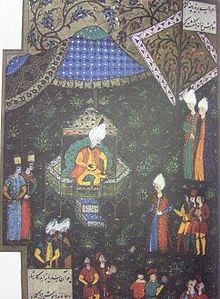
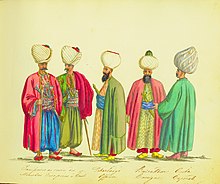
The Ottoman Empire began its expansion into Europe by taking the European portions of the Byzantine Empire in the 14th and 15th centuries up until the 1453 capture of Constantinople, establishing Islam as the state religion in the region. The Ottoman Empire continued to stretch northwards, taking Hungary in the 16th century, and reaching as far north as the Podolia in the mid-17th century (Peace of Buczacz), by which time most of the Balkans was under Ottoman control. Ottoman expansion in Europe ended with their defeat in the Great Turkish War. In the Treaty of Karlowitz (1699), the Ottoman Empire lost most of its conquests in Central Europe. The Crimean Khanate was later annexed by Russia in 1783. Over the centuries, the Ottoman Empire gradually lost almost all of its European territories, until its collapse in 1922, when the former empire was transformed into the nation of Turkey.
Between 1354 (when the Ottomans crossed into Europe at Gallipolli) and 1526, the Empire had conquered the territory of present day Greece, Bulgaria, Romania, Albania, Serbia, Macedonia, Montenegro, Bosnia and Hungary. The Empire laid siege to Vienna in 1683. The intervention of the Polish King broke the siege, and from then afterwards the Ottomans battled the Habsburg Emperors until 1699, when the Treaty of Karlowitz forced them to surrender Hungary, Croatia, and portions of present day Slovenia and Serbia. From 1699 to 1913, wars and insurrections pushed the Ottoman Empire further back until it reached the current European border of present-day Turkey.
For most of this period, the Ottoman retreats were accompanied by Muslim refugees from these province (in almost all cases converts from the previous subject populations), leaving few Muslim inhabitants in Hungary, Croatia, and the Transylvania region of present day Romania. Bulgaria remained under Ottoman rule until around 1878, and currently its population includes about 131,000 Muslims (2001 Census) (see Pomaks).

Bosnia was conquered by the Ottomans in 1463, and a large portion of the population converted to Islam in the first 200 years of Ottoman domination. By the time Austria-Hungary occupied Bosnia in 1878, the Habsburgs had shed the desire to re-Christianize new provinces. As a result, a sizable Muslim population in Bosnia survived into the 20th century. Albania and the Kosovo area remained under Ottoman rule until 1913. Previous to the Ottoman conquest, the northern Albanians were Roman Catholic and the southern Albanians were Christian Orthodox, but by 1913 the majority were Muslim.
Conversion to Islam
| The neutrality of this section is disputed. Relevant discussion may be found on the talk page. Please do not remove this message until conditions to do so are met. (March 2013) (Learn how and when to remove this message) |
Apart from the effect of a lengthy period under Ottoman domination, many of the subject population were converted to Islam as a result of a deliberate move by the Ottomans as part of a policy of ensuring the loyalty of the population against a potential Venetian invasion. However, Islam was not spread by force in the areas under the control of the Ottoman Sultan according to Thomas Walker Arnold. Rather Arnold explains Islam's spread by quoting a 17th-century author who stated:
Meanwhile he (the Turk) wins (converts) by craft more than by force, and snatches away Christ by fraud out of the hearts of men. For the Turk, it is true, at the present time compels no country by violence to apostatise; but he uses other means whereby imperceptibly he roots out Christianity...
Iberia and Southern France
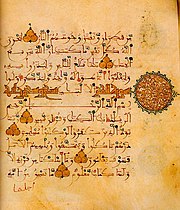

Muslim forays into Europe began shortly after the religion's inception, with a short lived invasion of Byzantine Sicily by a small Arab and Berber force that landed in 652. Islam gained its first foothold in continental Europe from 711 onward, with the Umayyad conquest of Hispania. The invaders named their land Al-Andalus, which expanded to include what is now Portugal and Spain except for the northern highlands of Asturias, Basque country, Navarra and few other places protected by mountain chains from southward invasions.
Al-Andalus has been estimated to have had a Muslim majority by the 10th century after most of the local population converted to Islam. This coincided with the La Convivencia period of the Iberian Peninsula as well as the Golden age of Jewish culture in Spain. Pelayo of Asturias began the Christian counter-offensive known as the Reconquista after the Battle of Covadonga in 722. Slowly, the Christian forces began a conquest of the fractured taifa kingdoms of al-Andalus. By 1236, practically all that remained of Muslim Spain was the southern province of Granada.
In the 8th century, Muslim forces pushed beyond Spain into Aquitaine, in southern France, but suffered a temporary setback when defeated by Eudes, Duke of Aquitaine, at the Battle of Toulouse (721). In 725 Muslim forces captured Autun in France. The town would be the easternmost point of expansion of Umayyad forces into Europe; just seven years later in 732, the Umayyads would be forced to begin their withdrawal to al-Andalus after facing defeat at the Battle of Tours by Frankish King Charles Martel. From 719 to 759, Septimania was one of the five administrative areas of al-Andalus. The last Muslim forces were driven from France in 759, but maintained a presence, especially in Fraxinet all the way into Switzerland until the 10th century. At the same time, Muslim forces managed to capture Sicily and portions of southern Italy, and even sacked Rome in 846 and later sacked Pisa in 1004.
Sicily

Sicily was gradually conquered by the Arabs and Berbers from 827 onward, and the Emirate of Sicily was established in 965. They held onto the region until their expulsion by the Normans in 1072.
The local population conquered by the Muslims were Romanized Catholic Sicilians in Western Sicily and partially Greek speaking Christians, mainly in the eastern half of the island, but there were also a significant number of Jews. These conquered people were afforded a limited freedom of religion under the Muslims as dhimmi, but were subject to some restrictions. The dhimmi were also required to pay the jizya, or poll tax, and the kharaj or land tax, but were exempt from the tax that Muslims had to pay (Zakaat). Under Arab rule there were different categories of Jizya payers, but their common denominator was the payment of the Jizya as a mark of subjection to Muslim rule in exchange for protection against foreign and internal aggression. The conquered population could avoid this subservient status simply by converting to Islam. Whether by honest religious conviction or societal compulsion large numbers of native Sicilians converted to Islam. However, even after 100 years of Islamic rule, numerous Greek speaking Christian communities prospered, especially in north-eastern Sicily, as dhimmi. This was largely a result of the Jizya system which allowed co-existence. This co-existence with the conquered population fell apart after the reconquest of Sicily, particularly following the death of King William II of Sicily in 1189.
Cultural impact and Christian interaction
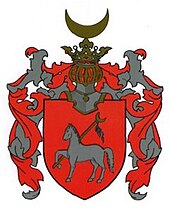
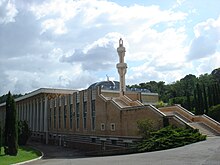
The Christian conquests of the Iberian peninsula and southern Italy helped to reintroduce ideas and concepts lost to the Western World after the fall of Rome in A.D. 476. Arab speaking Christian scholars saved influential pre-Christian texts and this coupled with the introduction of aspects of medieval Islamic culture (including the arts, agriculture, economics, philosophy, science and technology) assisted with fomenting conditions required for a rebirth of European thought and art (Renaissance). (See Latin translations of the 12th century and Islamic contributions to Medieval Europe for more information).
Muslim rule endured in the Emirate of Granada, from 1238 as a vassal state of the Christian Kingdom of Castile, until the completion of La Reconquista in 1492. The Moriscos (Moorish in Spanish) were finally expelled from Spain between 1609 (Castile) and 1614 (rest of Spain), by Philip III during the Spanish Inquisition.
Throughout the 16th to 19th centuries, the Barbary States sent Barbary pirates to raid nearby parts of Europe in order to capture Christian slaves to sell at slave markets in the Arab World throughout the Renaissance period. According to Robert Davis, from the 16th to 19th centuries, pirates captured 1 million to 1.25 million Europeans as slaves. These slaves were captured mainly from the crews of captured vessels and from coastal villages in Spain and Portugal, and from farther places like Italy, France or England, the Netherlands, Ireland, the Azores Islands, and even Iceland.
For a long time, until the early 18th century, the Crimean Khanate maintained a massive slave trade with the Ottoman Empire and the Middle East. The Crimean Tatars frequently mounted raids into the Danubian principalities, Poland-Lithuania, and Russia to enslave people whom they could capture.
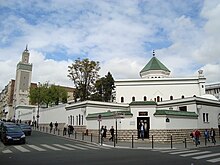
Cultural influences
Further information: Islamic contributions to Medieval Europe and Islamic Civilization during the European RenaissanceIslam piqued interest among European scholars, setting off the movement of Orientalism. The founder of modern Islamic studies in Europe was Ignác Goldziher, who began studying Islam in the late 19th century. For instance, Sir Richard Francis Burton, 19th-century English explorer, scholar, and orientalist, and translator of 'The Arabian Nights' The Book of One Thousand and One Nights, disguised himself as a Pashtun and visited both Medina and Mecca during the Hajj, as described in his book The Pilgrimage to Al-Medinah and Meccah
Islamic architecture influenced European architecture in various ways (for example, the Türkischer Tempel synagogue in Vienna). During the 12th-century Renaissance in Europe, Latin translations of Arabic texts were introduced. The Koran was also translated (for example, Lex Mahumet pseudoprophete).
Current population and its perception

According to the Pew Forum, the total number of Muslims in Europe in 2010 was about 44 million (6%), excluding Turkey. The total number of Muslims in the European Union in 2010 was about 19 million (3.8%). Approximately 9 million Turks are living in Europe, excluding the Turkish population of Turkey, which makes up the largest Muslim immigrant community in Europe. However the real number of Muslims in Europe is not well-known. The percentage of Muslims in Russia (the biggest group of Muslims in Europe) vary from 5 to 30%, depending on sources. It also depends on if only observant Muslims or all people of Muslim descent are counted.
The Muslim population in Europe is extremely diverse with varied histories and origins. Today, the Muslim-majority regions of Europe are Albania, Kosovo, parts of Bosnia and Herzegovina, parts of Bulgaria and Macedonia, as well as some Russian regions in Northern Caucasus and the Volga region. The Muslim-dominated Sandžak of Novi Pazar is divided between Serbia and Montenegro. They consist predominantly of indigenous Europeans of the Muslim faith whose religious tradition dates back several hundred years. The transcontinental countries of Turkey, Azerbaijan and Kazakhstan also are Muslim majority. The Muslim population in Western Europe is composed primarily of peoples who arrived to the European continent in or after (1945), when France declared itself a country of immigration. Muslim emigration to metropolitan France surged during the Algerian War of Independence. In 1961, West German Government invited first Gastarbeiters. Similar contracts were offered by Switzerland. The Muslim population tends to suffer Islamophobia all over Europe, although the perceptions and views of Muslims may vary.
The UN High Commissioner for Refugees estimated that 70% of the people of Albania are Muslim, 91% in Kosovo, and 30% of them in Macedonia are Muslim. Bosnia has a Muslim plurality. In transcontinental countries such as Turkey 99%, and 93% in Azerbaijan of the population is Muslim respectively. Muslims also form about one sixth of the population of Montenegro. In Russia, Moscow is home to an estimated 1.5 million Muslims.
Projections
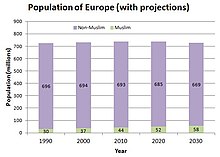
Don Melvin wrote in 2004 that, excluding Russia, Europe's Muslim population will double by 2020. He also says that almost 85% of Europe's total population growth in 2005 was due to immigration in general. Omer Taspinar predicted in 2001 that the Muslim population of Europe will nearly double by 2015, while the non-Muslim will shrink by 3.5%, if the higher Muslim birth rate persists. In the UK, between 2001 and 2009, the Muslim population increased roughly 10 times faster than the rest of the population.
A 2007 Center for Strategic and International Studies (CSIS) report argued that some Muslim population projections are overestimated. Philip Jenkins of Penn State University estimates that by 2100, Muslims will compose about 25% of Europe's population. Jenkins states this figure does not take account divergent birthrates amongst Europe's immigrant Christians. Other analysts are skeptical about the accuracy of the claimed Muslim population growth, stating that because many European countries do not ask a person's religion on official forms or in censuses, it has been difficult to obtain accurate estimates, and arguing that there has been a decrease in Muslim fertility rates in Morocco, the Netherlands and Turkey. A Pew Research Center study, published in January 2011, forecast an increase of Muslims in European population from 6% in 2010 to 8% in 2030. Pew also found that Muslim fertility rate in Europe would drop from 2.2 in 2010 to 2.0 in 2030. On the other hand, the non-Muslim fertility rate in Europe would increase from 1.5 in 2010 to 1.6 in 2030.
See also
- 2013 Woolwich attack
- 7 July 2005 London bombings
- A Common Word Between Us and You
- Discrimination in Europe
- Eurabia
- European Islam
- Islam by country
- Islamic dress in Europe
- Islamism
- Islamophobia
- Islamic Terrorism
- Islamophobic incidents
- List of cities in the European Union by Muslim population
- Persecution of Muslims
- Turks in Europe
- Women's rights and Islam
Organizations
- Catholic-Muslim Forum
- European Council for Fatwa and Research
- Muslim Council for Cooperation in Europe
- Muslim Executive of Belgium
References
- ^ Kettani, Houssain (2014). The World Muslim Population, History & Prospect. Singapore: Research Publishing Service. ISBN 978-981-07-7244-4.
- Vikings in the East, Remarkable Eyewitness Accounts
- Encarta, Mongol Invasion of Russia. Archived from the original on 2009-10-31.
{{cite encyclopedia}}: Unknown parameter|deadurl=ignored (|url-status=suggested) (help) - http://media.hoover.org/sites/default/files/documents/Macedonia_and_the_Macedonians_Andrew_Rossos_63.pdf
- Soldier Khan
- ^ The preaching of Islam: a history of the propagation of the Muslim faith By Sir Thomas Walker Arnold, pg. 135-144
- ^ Hourani, Albert, History of the Arab Peoples, Faber & Faber, 2002, ISBN 0-571-21591-2
- Manfred, W: "International Journal of Middle East Studies", pages 59-79, Vol. 12, No. 1. Middle East Studies Association of North America, Aug 1980.
- Roger II - Encyclopædia Britannica
- Tracing The Norman Rulers of Sicily
- Archived link: From Islam to Christianity: the Case of Sicily, Charles Dalli, page 153. In Religion, ritual and mythology : aspects of identity formation in Europe / edited by Joaquim Carvalho, 2006, ISBN 88-8492-404-9.
- ^ "British Slaves on the Barbary Coast".
- "Jefferson Versus the Muslim Pirates by Christopher Hitchens, City Journal Spring 2007".
- Milton, G (2005) White Gold: The Extraordinary Story of Thomas Pellow And Islam's One Million White Slaves, Sceptre, London
- "The Crimean Tatars and their Russian-Captive Slaves" (PDF). Eizo Matsuki, Mediterranean Studies Group at Hitotsubashi University.
- "Historical survey > Slave societies". Encyclopædia Britannica,
- ^ Pew Forum, The Future of the Global Muslim Population, January 2011, , ,
- Cole, Jeffrey (2011), Ethnic Groups of Europe: An Encyclopedia, ABC-CLIO, p. 367, ISBN 1-59884-302-8
- by example only 6% of the Russian population is Islamic here
- European Monitoring Centre on Racism and Xenophobia (2006): Muslims in the European Union. Discrimination and Islamophobia Retrieved September 25, 2012
- Religiousfreedom.lib.virginia.edu
- Religiousintelligence.co.uk
- "Albania". Religious Intelligence. United States Department of State. Retrieved 2008-07-27.
{{cite web}}: Cite has empty unknown parameter:|coauthors=(help) - "Embassy of the Republic of Kazakhstan in the UK, Country Profile 2007, p.4" (PDF). Retrieved 2007-06-21.
- The rise of Russian Muslims worries Orthodox Church, The Times, 5 August 2005
- ^ Don Melvin, Europe works to assimilate Muslims, Atlanta Journal Constitution, 2004-12-17, Error in Webarchive template: Empty url.
- Tolerance and fear collide in the Netherlands, UNHCR, Refugees Magazine, Issue 135 (New Europe)
- Migration Information Source - Europe: Population and Migration in 2005
- Omer Taspinar, Europe's Muslim Street, Brookings Institution, march 2003
- Muslim population 'rising 10 times faster than rest of society' January 30, 2009, Richard Kerbaj, The Sunday Times
- Esther Pan, Europe: Integrating Islam, Council on Foreign Relations, 2005-07-13
- Philip Jenkins, Demographics, Religion, and the Future of Europe, Orbis: A Journal of World Affairs, vol. 50, no. 3, pp. 533, summer 2006
- Mary Mederios Kent, Do Muslims have more children than other women in western Europe?, Population Reference Bureau, February 2008, Simon Kuper, Head count belies vision of ‘Eurabia’, Financial Times, 19 August 2007, Doug Saunders, The 'Eurabia' myth deserves a debunking , The Globe and Mail, 20 September 2008, Islam and demography: A waxing crescent, The Economist, 27 January 2011
Further reading
- Ghodsee, Kristen (2009). Muslim Lives in Eastern Europe: Gender, Ethnicity and the Transformation of Islam in Postsocialist Bulgaria. Princeton: Princeton University Press. ISBN 978-0-691-13955-5.
External links
- For Muslim Minorities, it is Possible to Endorse Political Liberalism, But This is not Enough
- BBC News: Muslims in Europe
- Khabrein.info: Barroso: Islam is part of Europe
- Euro-Islam Website Coordinator Jocelyne Cesari, Harvard University and CNRS-GSRL, Paris
- Asabiyya: Re-Interpreting Value Change in Globalized Societies
- Why Europe has to offer a better deal towards its Muslim communities. A quantitative analysis of open international data
- Köchler, Hans, Muslim-Christian Ties in Europe: Past, Present and Future, 1996
| Islam in Europe | |
|---|---|
| Middle Ages | |
| Early Modern | |
| Modern | |
| Contemporary issues | |
| By country |
|
| Muslims in Europe | |||||||||||||
|---|---|---|---|---|---|---|---|---|---|---|---|---|---|
| Majority |
| ||||||||||||
| Minority | |||||||||||||
